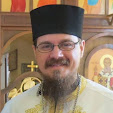 |
| St. Paul. From the Acts of the Apostles printed in Tbilisi, Georgia, in 1709 |
The Fathers of the Church consistently echo the Lord’s prayer for His people, the Church, “that they may all be one” (John 17:21). As surely as we know that the Father hears and answers the prayers of Jesus Christ His Son, we know that this petition describes a reality and not only a hope. The Church is one, as much now as in the patristic age. That unity manifests on several levels. St. Paul writes, “There is one body and one Spirit…, one Lord, one faith, one baptism, one God who is Father of all” (Eph 4:4-6). Reflecting the unity of God, there is unity of doctrine, unity of the Church, and unity of all in charity. Much of what occasioned the Fathers’ writings and the biblical writings on the subject of unity were attacks on that unity by heresies, schisms, and personal squabbles between Christians. These faults betray the oneness of the Body of Christ and vainly seek to rend it asunder.
| St. Ignatius of Antioch |
“There is one body” (Eph 4:4). This Body of Jesus Christ is the Church and its unity is visible and manifest particularly among believers united under the episcopacy. This image of the one body united under one head was particularly favored by Ignatius of Antioch (c. 35 – 98 A.D.). He wrote, “Wherever the bishop shall appear, there let the multitude also be; even as, wherever Jesus Christ is, there is the Catholic Church.” It is by our unity with the bishop, the visible representative of God, according to Ignatius, that we are one Church and one Body. Ignatius also employs a pastoral image of the shepherd to describe the role of the bishop in the Church. He counsels, “Where the shepherd is, there do ye as sheep follow.” Leo the Great (400 – 461 A.D.) later also testifies to the role of the bishops in preserving and signifying the unity of the Church. In a letter to certain Egyptian bishops, he uses a similar pastoral image and begs them “to assist in maintaining unity and bringing back wanderers to the fold.” There have always been wanderers from the fold, lost sheep gone astray and in need of a shepherd to draw them back to the true faith.
 |
| Pope St. Leo the Great |
Though heresy does indeed present a threat to the unity of the Church, there is an important distinction between heresy and difference of opinion. Speaking of the appropriate relations between parties with differing doctrinal opinions, Augustine writes,
With anxious piety, they showed toleration towards each other, though without violation of Christian charity they entertained different opinions, endeavoring to keep the unity of the Spirit in the bond of peace till God should reveal to one of them, were he otherwise minded, even this error of his ways.
 |
| Greek icon of St. Augustine of Hippo |
“There is one… Father of all” (Eph 4:4, 6). Therefore, we are all brethren. "Let us say Brethren, even to those who hate us," writes Gregory the Theologian, for the sake of the Resurrection of the Body of Christ. This celebrated phrase is inserted into the Resurrection Canon which the Byzantine Churches repeat joyfully each Pascha. It well expresses the type of unity which is greatest – the unity of love for all, even for our enemies. This is the unity that is testified to even by the Psalmist long before the coming of Christ, when he writes,
How good and how pleasant it is when brethren live in unity. It is like precious oil upon the head, running down the beard, running down upon Aaron's beard, upon the collar of his robes (Ps 133).
Russian icon of Aaron
from the 18th cen. Iconostasis
of Kizhi monastery
in Karelia, Russia
The biblical and patristic claim that we are all brethren and all children of one God who is Father of all aspires to a unity deeper even than that which is accomplished by unity of faith and ecclesiastical unity. As Paul writes, “If I have all faith, so as to remove mountains, but have not love, I am nothing” (1 Cor 13:2). Truly, each aspect of unity is essential and supports the whole. Notwithstanding, there are three kinds of unity – unity of belief, ecclesiastical unity, and unity of charity – but the greatest of these is charity.














2 comments:
Good sermon. I particularly like the analogy to precious oil running down one's beard.
Thanks, Salai. Psalm 133 is far and away my favorite psalm, perhaps my favorite passage in scripture.
Post a Comment